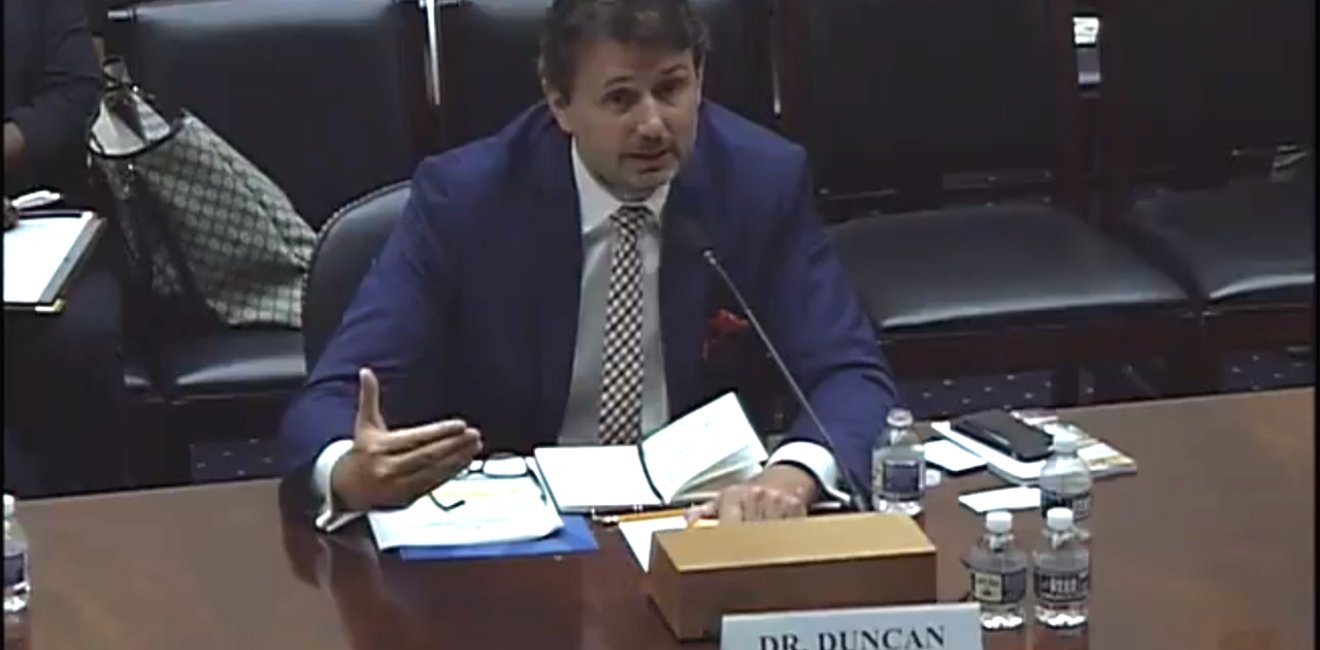Testimony as prepared:
Watch the Full Hearing >>The New Vitality of US-Mexico Energy Cooperation
Over the past three years, the United States and Mexico have deepened their cooperation on energy issues to an extent never before seen. By January of 2017, the NAFTA partners had developed complementary approaches to questions of energy markets, emissions controls, infrastructure planning and regulatory cooperation. Through bilateral meetings, and through the trilateral mechanism of the energy ministers meetings and the North American Cooperation Energy Information initiative, mutual understanding and shared interests were being discussed in ways that would have been unthinkable even five years before. Having approved a landmark energy reform in 2013, Mexico is now open and willing to cooperate with the United States in a wide variety of ways.
This testimony argues that the United States should embrace energy cooperation with Mexico on a wide range of issues, and must not abandon bilateral collaboration on climate change. Furthermore, the trilateral energy dialogue with Canada must continue through regular meetings of the North American energy ministers, which will bring mutual benefit, increased prosperity, and a stronger presence on the global stage. Particularly in the light of President Trump’s decision to pull the United States out of the Paris Climate Accord, regional cooperation that is equitably negotiated will provide the three countries with a mechanism for continued emissions collaboration. The successes of the past three years in oil and gas, renewables and climate cooperation stand as evidence of the mutual benefits to be had from this process.
Why this matters
Before analyzing the progress that has been made in the bilateral and regional energy relationship, it is worth remembering why energy matters so much. Of course it is a major component of both countries’ economies, responsible for wealth creation, innovation, and employment. Across Mexico and the United States, millions of people work in the traditional energy sector, and millions more are finding work in the areas of renewable energy and energy efficiency.
But secure access to comparatively low-priced energy is also crucial for economic competitiveness. For example, prior to Mexico’s energy reform, high prices for industrial consumers of electricity compromised manufacturing competitiveness in the country, and natural gas shortages meant repeated stoppages at factories in the north of the country. Since the reform was passed, prices have been reduced dramatically in Mexico, falling by between 21 percent and 30 percent for industrial consumers between September 2014 and September 2015. This has significantly improved the economic competitiveness of Mexican manufacturers, in turn improving the competitiveness of the North American manufacturing platform.
Recent patterns of cooperation
For decades, Mexican sensitivities regarding the connection between energy and national sovereignty prevented the development of a modern and multifaceted dialogue over energy cooperation between the two countries. The 2013 reform, however, opened the way for comprehensive interaction on energy policy. In February 2014, only two months after the reform was approved, the three North American heads of government met in Toluca, in the State of Mexico, to discuss the future of regional integration. Energy featured high on the agenda, and it was agreed that the energy ministers of the three countries would begin a regular dialogue. The first meeting took place in Washington, D.C., in December 2014, and agreed on an agenda for cooperation on three specific points:
1. Publicly available collaboration on North American energy data, statistics, and mapping;
2. Responsible and sustainable best practices for unconventional oil and gas developments; and
3. A modern, resilient energy infrastructure for North America, including policies, regulations, workforce, innovation, energy efficiency practices, and sustainable technologies.
The breadth of this agenda helps to emphasize the potential for collaboration now that the Mexican energy system has been transformed. The memorandum of understanding signed by the energy minsters institutionalized an information-sharing framework for participants to promote dialogue and cooperation. Under the North American Cooperation on Energy Information initiative (NACEI), the three ministers agreed to set up a working group that would facilitate this coordination, combining the efforts of the three countries’ energy departments and information agencies, statistics and census bureaus, and national energy control and regulatory boards. The group was specifically tasked with comparing, validating, and improving respective energy import and export information; sharing publicly available geospatial information on energy infrastructure; exchanging views and information on cross-border energy flows; and harmonizing terminology, concepts, and definitions of energy products.
The NACEI immediately began to gather statistics and map resources. The result is an impressive resource that allows for a truly regional understanding of energy resources for the first time. The maps created thus far are an extraordinary visual resource of energy infrastructure across North America and expand the potential for cross-border cooperation and planning in a way that had not been possible before. What is more, the harmonization of statistics from all three countries allows for meaningful and simple comparisons. In this way, the North American energy dialogue has opened the way for deep long-term collaboration.
The leadership role played by the United States in this regional approach was underlined by the 2015 Quadrennial Energy Review (QER), which focused extensively on the opportunities for energy cooperation in North America. The QER chapter on North America concluded that the United States has significant energy trade with Canada ($140 billion per year) and Mexico ($65 billion), yet greater coordination is needed to improve energy system efficiency and build resiliency against disruptions of the North American energy market, data exchanges, and regulatory harmonization.
In 2015, the U.S. Energy Information Administration (EIA), Canada’s National Energy Board, and Mexico’s Secretaría de Energía (SENER) produced a Trilateral Energy Outlook. This report established projections for crude oil, refined products, and natural gas and electricity markets across the region to 2029. Although the report’s authors emphasize that “it does not reflect results of an integrated North American energy model” nor should it “be construed as an official outlook for any of the Trilateral members,” there is, for the first time, the possibility of a more holistic approach to planning the future of North America’s energy sector.
The December 2014 meeting of the energy ministers was followed in May 2015 by a meeting on the margins of the Energy and Climate Partnership of the Americas and the Clean Energy ministerial meetings in Mérida, Mexico. The three ministers agreed to form a new Working Group on Climate Change and Energy, involving regular interactions between teams from all three countries. The agenda that was laid out in Mérida included reliable, resilient, and low-carbon electricity grids; more focus on clean energy and energy efficiency, including energy management systems; carbon capture, use, and storage; climate change adaptation and resilience; and oil and gas sector emissions, including methane and black carbon. The energy ministers praised the new initiative. Mexico’s Pedro Joaquin Coldwell emphasized that its agenda demonstrated a commitment to “a path to achieve deep de-carbonization.” United States Energy Secretary Ernest Moniz emphasized the initiative’s potential for “facilitating cooperation to deploy innovative renewable energy technologies, modernize the grid, and increase energy efficiency to combat climate change and reach greenhouse gas targets while growing low-carbon economies in North America.”
This institutionalization of a regional energy and climate agenda is a prerequisite for meaningful and sustained cooperation. Building on the experience of the North American Energy Working Group (NAEWG) in the early 2000s, the new working group will coordinate its efforts through socialization and harmonization. The first process has already shown its value: the meetings of the three energy policy representatives have encouraged mutual understanding and increased interaction between their ministries. The second process will take longer, and we should not expect it to be a linear or an even process. It makes more sense to harmonize regulations and standards in some areas than in others, and sometimes the harmonization should be bilateral rather than trilateral. In most areas, the goal should be compatibility and coordination rather than full homogenization.
Another area that has progressed impressively since 2013 has been regulatory cooperation. As Mexico has opened its sector to private participation, its regulatory agencies have been strengthened and their power expanded. The CNH has been charged with running the bidding process for oil blocks in Rounds 1 and 2, and the Comision Reguladora de Energia (CRE) has overseen both the opening of the electricity market alongside SENER and the CENACE, and the regulation of transportation, storage, and distribution of hydrocarbons, including natural gas. Furthermore, the reforms created a new environmental regulatory agency, the Agencia de Seguridad, Energia y Ambiente (ASEA), to oversee the industrial safety and environmental protection aspects of the hydrocarbons sector. Operating under the control of the environmental ministry (SEMARNAT), the ASEA has had to progress rapidly since its inception in 2015. In fact, all three regulatory agencies have had to adapt to dramatically altered circumstances during the first three years of Mexico’s new energy model. To do so, they have made a concerted effort to acquaint themselves with international best practices, and Mexican contact with U.S. and Canadian regulators has been an integral part of that process. Regulatory exchanges with California and Texas (and Alberta) have been particularly significant, as have exchanges with U.S. federal organizations such as the Bureau of Safety and Environmental Enforcement, the Bureau of Ocean Energy Management, the Bureau of Land Management, the Environmental Protection Agency, the Federal Energy Regulatory Commission, and the Pipeline and Hazardous Materials Safety Administration.
U.S.-Mexico Climate Cooperation
Mexico has long been recognized as an emerging market leader in international climate change negotiations. Beginning with the presidency of Felipe Calderón, Mexico has attempted to develop an aggressive approach to global climate talks that is backed up by progress on climate mitigation and renewable energy policy at home. President Peña Nieto’s continuation of this policy surprised some who had predicted a hydrocarbons-friendly approach, and has even strengthened Mexico’s global climate position by securing legislation in Mexico’s Congress for a 50 percent reduction in carbon emissions by 2050, alongside ambitious targets for electricity generation from renewable sources. Mexico was also the first developing country to declare its Intended Nationally Determined Contribution for greenhouse gas reductions under the Paris Accord process in April 2015, and has undertaken a commitment to reduce its black carbon emissions by 51 percent by 2030. Largely thanks to this commitment, Mexico and the United States became partners in pushing the Paris Accord in December 2015, setting the stage for further regional cooperation.
The North American energy dialogue has also been an important force driving cooperation on climate issues. In July 2016, at the Ottawa North American Leaders’ Summit, Mexico agreed to join the existing U.S.-Canada agreement on methane emissions reductions. The trilateral accord commits the countries to reducing methane emissions from the hydrocarbons industry by up to 45 percent by 2025. Mexico had previously resisted a commitment to reduce its emissions, partly because of opposition from Pemex and partly because of the energy reform’s already overwhelming agenda. Alongside pressure from the Canadian and U.S. governments, extensive efforts by civil society groups, including the Environmental Defense Fund (EDF) to promote the emissions reductions were successful in convincing the Peña Nieto administration of the importance of a trilateral accord. The EDF, quoting Mexican government figures, estimate that methane emissions from the hydrocarbon industry make up 19 percent of total methane emissions in the country. Trilateral cooperation can also be credited with 2016’s most important global climate accord, the Kigali Agreement on phasing out hydrofluorocarbons (HFCs) in October. In 2009, during a meeting of the Montreal Protocol, the United States, Canada, and Mexico (plus the Maldives) pushed for international cooperation to reduce HFC emissions as a crucial component of fighting climate change.
Prospects for cooperation
Given the energy policy priorities of the current U.S. administration, there are three areas that would be of considerable mutual interest:
· Energy trade
· Regulatory simplification
· Infrastructure
To collaborate effectively on all of these areas, it is imperative that the North American Energy Ministers Dialogue is continued. The regional cooperative mechanism that has been developed over the past three years will prove to be of great utility in identifying future challenges and working effectively to resolve them.
The two-way energy trade
Mexico is an important partner for the United States in the energy trade, serving as both friendly oil supplier and a growing market for U.S. exports. It has long been recognized that ensuring “friendly suppliers,” such as Canada and Mexico, should be a goal of U.S. energy policy, and indeed then-candidate Trump made this part of his energy election platform. What’s more, although U.S. energy independence will take a long time, most experts recognize that North American energy independence is an achievable target at which to aim. This means that the United States should recognize the importance of ensuring the long-term success of Mexico’s energy reforms.
Two factors make this point particularly relevant. First, Mexico has seen a prodigious decline in oil production in recent years and the reforms are the best hope of reversing that decline (see figure 1). Secondly, the reform has come under attack from opposition parties in Mexico and, with the possibility of a shift to the left in the 2018 presidential election, there is a risk that the reform will stall or be rolled back. This would be an alarming prospect for both the United States and for a number of its companies that have been successful in first-round oil contract bidding.
See Figure 1 in attached document: Mexican vs. U.S. Oil Production, 2001–16 (thousands of barrels per day)
It is also worth focusing on the Trump administration’s goal of boosting natural gas production and use. If gas production is to grow in the United States, new consumers will be needed to sustain a price that allows for investment in the sector. Fortunately for gas producers, it is expected that Mexico will see its demand for natural gas grow rapidly, and it is estimated that exports to Mexico will soon reach between 8 and 10 percent of U.S. production (figure 2). Mexico plans to dramatically boost its internal natural gas pipeline network over the next few years, and it is expected to grow more than 90 percent before the end of the decade. In addition to satisfying demand in Mexico, in the long term there is the opportunity to export U.S. natural gas via pipeline to Central America and through liquid natural gas facilities built along the Mexican coast. Although this could also, of course, be achieved in the United States, zoning restrictions and social license problems often make these projects costly and difficult to complete on time. In Mexico, there would likely be an easier path to construction, though social opposition to energy projects has been a growing problem in recent years.
See Figure 2 in attached document: U.S. Natural Gas Production and Exports to Mexico
There is also a growing market in Mexico for U.S. refined products. After the country’s 2013 energy reform, there has been a liberalization of Mexico’s downstream and retail markets, driving a growing demand for imported gasoline and other products from the United States (which is also due to the sorry state of Mexico’s refining and petrochemicals industry at the present time). According to the EIA, the value of U.S. energy exports to Mexico are now more than twice that of imports from Mexico. This growing market provides both prosperity and price support for U.S. producers. What’s more, it is a trade surplus for the United States that is likely to grown in years to come.
See Figure 3 in attached document: US-Mexico Energy Trade
Regulatory Simplification
The second element, regulatory simplification, provides a compelling opportunity for Mexico to work with the United States to reduce the burden of its own regulatory system for energy firms. Although its regulations and regulatory bodies have seen substantial progress since the 2013 reforms, Mexico still has a regulatory system in place that seeks to prohibit, rather than facilitate, activity by the energy industry. The change of tone in the U.S. administration provides an opportunity for Mexico’s regulatory agencies to develop a dialogue with their U.S. counterparts that focuses on efficient regulation, something that the emerging private oil and gas industry is crying out for in Mexico. Critical issues concern repetitive paperwork, interagency coordination, permitting, and the use of online compliance mechanisms. If the United States is about to see a concerted push toward more efficient regulation, then it behooves Mexico to follow suit, to maintain competitiveness and to facilitate the integration of energy markets. Existing dialogue with state regulators in Texas have already emphasized the importance of a paradigm shift in Mexican regulation; the approach of the new U.S. government offers a chance to take that conversation further, in forums such as the existing North American dialogue. This agenda becomes doubly important in the light of prospective political change in Mexico in 2018.
Infrastructure
There are ample opportunities for ongoing energy infrastructure projects that take into account the increasingly integrated nature of U.S. and Mexican energy markets, from oil and gas pipelines to cross-border transmission lines and a coordinated approach to refining capacity. A crucial element of the success of the Mexican energy reform has been the arrival of natural gas from the United States through cross-border pipeline projects (see figure 4). These pipelines took years to plan and build, and it is vital that future Mexican demand is considered with enough anticipation to ensure that pipeline capacity exists to carry gas to market.
See Figure 4 in attached document: U.S.-Mexico Cross-border Natural Gas Pipelines
Mexico’s refineries are likely to see an overhaul in the next few years as Pemex seeks partners for its refining division that consistently loses around US$9 billion a year. If Mexico plans to invest in building new refining capacity, it would be wise to consider the current and future state of the U.S. refining sector, which is aging and has limited capacity. Once again, institutionalized cooperation between the North American energy ministers is an excellent and existing option for analyzing the case for new infrastructure planning.
The outlook for Mexico’s energy reform
The extraordinary successes of the past 3 and a half years have transformed Mexico’s energy sector from an almost entirely closed model to one of the most open in the world. Mexico is benefiting from growing foreign and national investment in the sector as well as competitive prices for electricity. But the new energy model in Mexico continues to face serious challenges. According to public opinion polls, the reform is still deeply unpopular, and rising gasoline prices due to currency volatility and the removal of subsidies has turned more people against the reform. This is feeding into growing support for parties that opposed the reform process and have committed themselves to repealing it. Andres Manuel Lopez Obrador’s (AMLO) MORENA party will fight the 2018 presidential and congressional elections on a platform that includes overturning the opening. Were he to win the presidency, it is highly unlikely that he would be able to generate the two-thirds majorities in the Mexican Congress (plus a majority of state-level legislatures) required to repeal the reforms. Instead, he has promised a referendum on the future of the reform. Although legal specialists argue that a referendum would be insufficient for repealing the reform (due to the fact that it directly impacts state revenues), the commitment is indicative AMLO’s antagonism to energy liberalization.
This suggests that a MORENA government in Mexico would take other steps to neutralize the reform, including attacking regulatory agency autonomy, enacting less business-friendly fiscal terms, or simply refusing to offer new oil and gas blocks for investment. Such measures would be highly detrimental to U.S. public and private interests and would be deeply negative for Mexico’s future energy production.
Conclusion
By early 2017, the energy relationship between Mexico and the United States had reached a historic high point. Mexico’s new energy model, based on market dynamics and attracting private and foreign investment, has opened the way for a highly constructive and productive dialogue between national authorities and their U.S. and Canadian counterparts. Regular meetings of the energy minsters of the three NAFTA countries have helped deepen mutual understanding and further energy cooperation at both the regional and global levels.
Our two nations have an unprecedented opportunity to build an even stronger energy relationship. Existing North American cooperation, the progress seen under the energy reform and the interest of the U.S. administration in helping the energy sector to grow, provide the ideal platform for a vibrant dialogue on these issues, one that can drive prosperity and employment creation in both nations.






